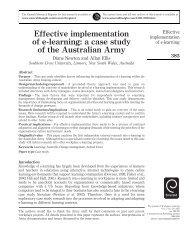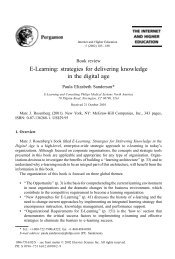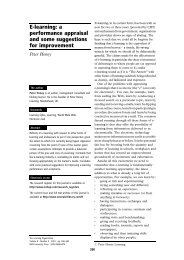Designing E-learning Interactions in the 21st Century: revisiting and ...
Designing E-learning Interactions in the 21st Century: revisiting and ...
Designing E-learning Interactions in the 21st Century: revisiting and ...
Create successful ePaper yourself
Turn your PDF publications into a flip-book with our unique Google optimized e-Paper software.
Andrew Ravenscroft 147<br />
successful exchanges is h<strong>in</strong>t<strong>in</strong>g. From a more detailed analysis of <strong>the</strong> co-occurence<br />
of <strong>the</strong>se speech acts <strong>and</strong> <strong>the</strong>ir position with<strong>in</strong> exchanges we can beg<strong>in</strong> to suggest<br />
common strategies for directed l<strong>in</strong>es of reason<strong>in</strong>g which tutor <strong>and</strong> student(s)<br />
engage <strong>in</strong> (Katz, 1997).<br />
The studies described above all suggest <strong>the</strong> potential of dialogue analysis for<br />
reveal<strong>in</strong>g important <strong>in</strong>sights <strong>in</strong>to educational argumentation <strong>and</strong> collaboration<br />
that can be fed <strong>in</strong>to <strong>in</strong>teraction design. However, <strong>the</strong>re is much still to <strong>in</strong>vestigate<br />
both <strong>in</strong> natural <strong>and</strong> CMC contexts before we can be confident about <strong>the</strong> relative<br />
importance of <strong>the</strong> factors discussed above or <strong>the</strong> reliability of <strong>the</strong>se f<strong>in</strong>d<strong>in</strong>gs (Chi,<br />
1997). Yet, given <strong>the</strong> role of dialogue <strong>in</strong> conceptual development, <strong>the</strong>re is a<br />
press<strong>in</strong>g need to develop <strong>in</strong>telligent systems <strong>and</strong> <strong>in</strong>terfaces that can engage <strong>the</strong>ir<br />
users <strong>in</strong> such discourses. A more direct approach to this problem, mentioned<br />
earlier, is <strong>the</strong> methodology of <strong>in</strong>vestigation by design, proposed by Ravenscroft &<br />
Pilk<strong>in</strong>gton (2000). This comb<strong>in</strong>es discourse analysis <strong>and</strong> dialogue game<br />
techniques to specify formal dialogue models implemented as <strong>in</strong>telligent dialogue<br />
systems. A central tenet of this approach is to take some of <strong>the</strong> features of<br />
successful dialogue Ð as yet not fully proven to be effective Ð <strong>and</strong> actively design<br />
<strong>the</strong>m <strong>in</strong>to <strong>in</strong>teraction scenarios aimed at support<strong>in</strong>g <strong>learn<strong>in</strong>g</strong>. Once <strong>the</strong>se models<br />
have been developed, we can evaluate <strong>the</strong>ir effectiveness, <strong>and</strong> systematically vary<br />
<strong>the</strong> roles, strategies, tactics <strong>and</strong> moves adopted to fur<strong>the</strong>r explore <strong>the</strong> utility of<br />
<strong>the</strong>se features <strong>in</strong> guid<strong>in</strong>g learners towards more systematic reason<strong>in</strong>g.<br />
The DISCOUNT discourse analysis scheme describes many different moves<br />
<strong>and</strong> rhetorical relations seen <strong>in</strong> dialogue <strong>and</strong> provides a useful abstract<br />
representation of <strong>the</strong>se features. By re-comb<strong>in</strong><strong>in</strong>g <strong>the</strong>se features at different<br />
levels, different strategies for support<strong>in</strong>g learners through <strong>in</strong>teraction can be<br />
modelled. However, to build suitable dialogue models, DISCOUNT type<br />
descriptions have to be made prescriptions <strong>and</strong> comb<strong>in</strong>ed with decision mak<strong>in</strong>g<br />
processes to plan turns. Moreover, <strong>in</strong> order for such plann<strong>in</strong>g to be made possible,<br />
<strong>the</strong> systems need to be able to categorise <strong>in</strong>put accord<strong>in</strong>g to its speech-act<br />
function. Dialogue game <strong>the</strong>ory (MacKenzie, 1979; Walton, 1984), that was<br />
mentioned earlier, is <strong>the</strong> design paradigm that enables this.<br />
Research <strong>in</strong>vestigat<strong>in</strong>g <strong>and</strong> exam<strong>in</strong><strong>in</strong>g <strong>the</strong> suitability of this approach has been<br />
ongo<strong>in</strong>g for <strong>the</strong> past ten years (Pilk<strong>in</strong>gton, 1992; Pilk<strong>in</strong>gton, Hartley, H<strong>in</strong>tze &<br />
Moore, 1992; Moore, 1993; Ravenscroft, 1997; Pilk<strong>in</strong>gton, 1999; Burton, Brna &<br />
Pilk<strong>in</strong>gton, 1999; Ravenscroft, 2000; Ravenscroft & Pilk<strong>in</strong>gton, 2000). These<br />
projects have shown that dialogue game <strong>the</strong>ory (Lev<strong>in</strong> & Moore, 1977;<br />
MacKenzie, 1979; Walton, 1984) can be used as a software design paradigm for<br />
types of computer-mediated <strong>and</strong> computer-based argumentation dialogue <strong>in</strong><br />
educational contexts. Here, <strong>the</strong> notion of a game is used to characterise <strong>and</strong> specify<br />
discourse <strong>in</strong> terms of <strong>the</strong> goals of <strong>the</strong> <strong>in</strong>terlocutors (e.g. <strong>the</strong> elaboration of<br />
knowledge, <strong>the</strong> co-elaboration of knowledge, support<strong>in</strong>g or w<strong>in</strong>n<strong>in</strong>g an<br />
argument), <strong>the</strong> relative roles of participants (e.g. <strong>in</strong>quirer, critiquer, expla<strong>in</strong>er)<br />
<strong>and</strong> <strong>the</strong> types of dialogue tactics <strong>and</strong> moves that are performed (e.g. Assertion,<br />
Challenge, Withdraw). Also, rules govern <strong>the</strong> types of moves available to<br />
participants, <strong>the</strong> effect <strong>the</strong>se have on commitment Ð to beliefs Ð <strong>and</strong> issues of<br />
<strong>in</strong>itiative <strong>and</strong> turn-tak<strong>in</strong>g. Note that, <strong>in</strong> focus<strong>in</strong>g on pragmatic level knowledge,<br />
<strong>the</strong>se projects have not needed to directly address issues of semantic <strong>and</strong> syntactic<br />
level natural language process<strong>in</strong>g <strong>and</strong> generation that have been exam<strong>in</strong>ed by<br />
Pilk<strong>in</strong>gton (1992) <strong>and</strong> Pilk<strong>in</strong>gton & Grierson (1996).<br />
ß Blackwell Publishers Ltd 2001
















